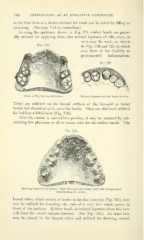Page 750 - My FlipBook
P. 750
748 ORTHODONTIA AS AN OPERATIVE PROCEDURE.
SO far that there is a doubt whether the tooth can be saved by filling or
crowning. (See page 744 on extraction.)
In using the appliance shown in Fig. 725 rubber bands are gener-
ally utilized for applying force, but twisted ligatures of silk, linen, or
wire may be used, as shown
Fi(}. 726.
in Figs. 726 and 727, in which
case there is less liability to
pericemental inflammation.
Fif!. 727.
(Same as Fig. 725, but with wire.) Twisted ligatures of silk, linen, or wire.
Tubes are soldered on the buccal surfaces of the bicuspid or molar
bands and shaped so as to serve for hooks. They are afterward utilized
for holding a labial bow (Fig. 729).
After the canine is moved into position, it may be retained by sub-
stituting fine platinum or silver suture wire for the rubber bauds. The
Fig. 728.
Showing migration of molars. Right first molar in eontact with first bicuspid, and
left touching the canine.
buccal tubes, which served as hooks in the first case (see Fig. 726), may
now be utilized for inserting the ends of a wire bow which passes in
front of the incisors. Rubber bands or twisted ligatures from this bow
will draw the lateral inci.sors forward. (See Fig. 729.) An inner bow
may be placed in the lingual tubes and utilized for drawing central


